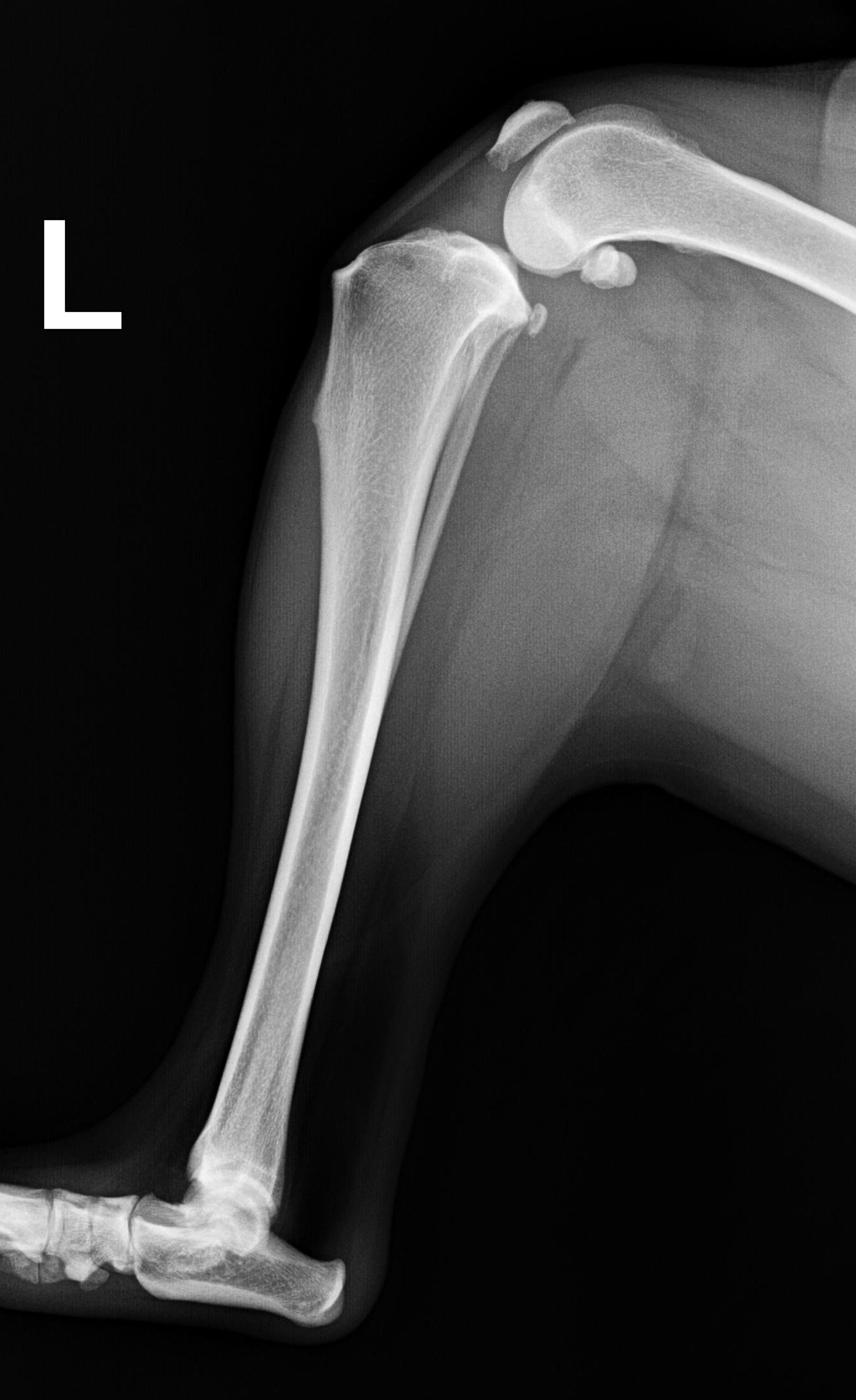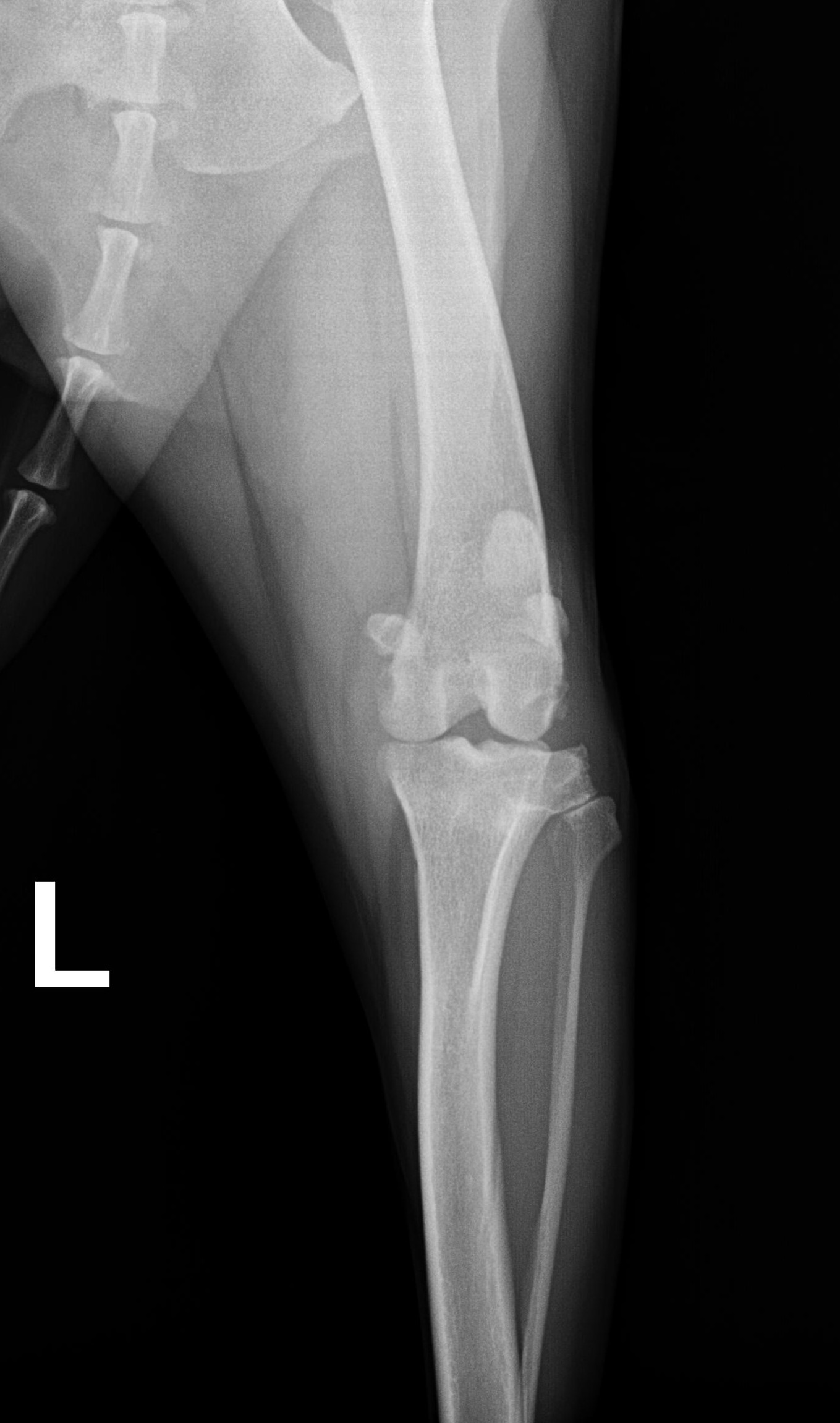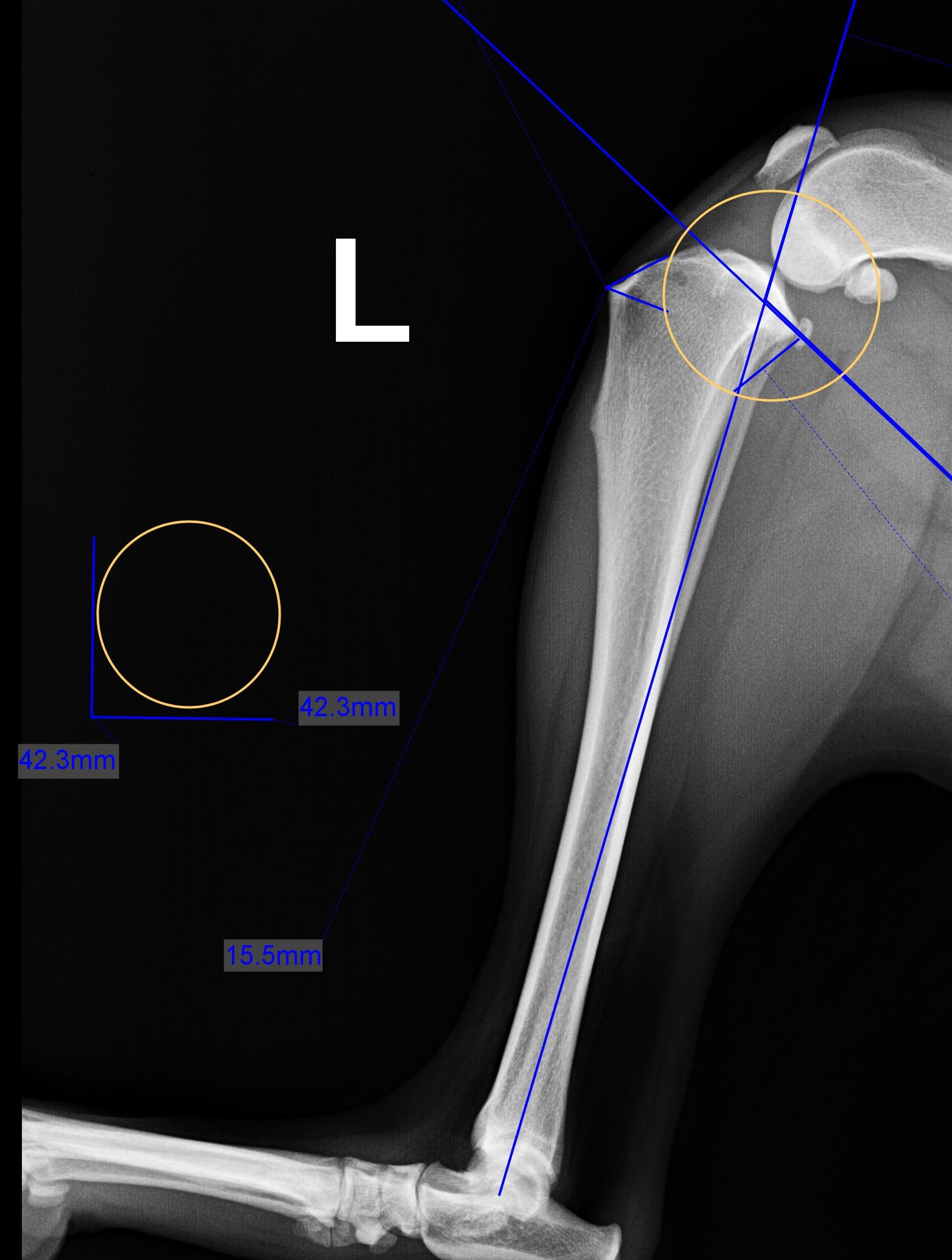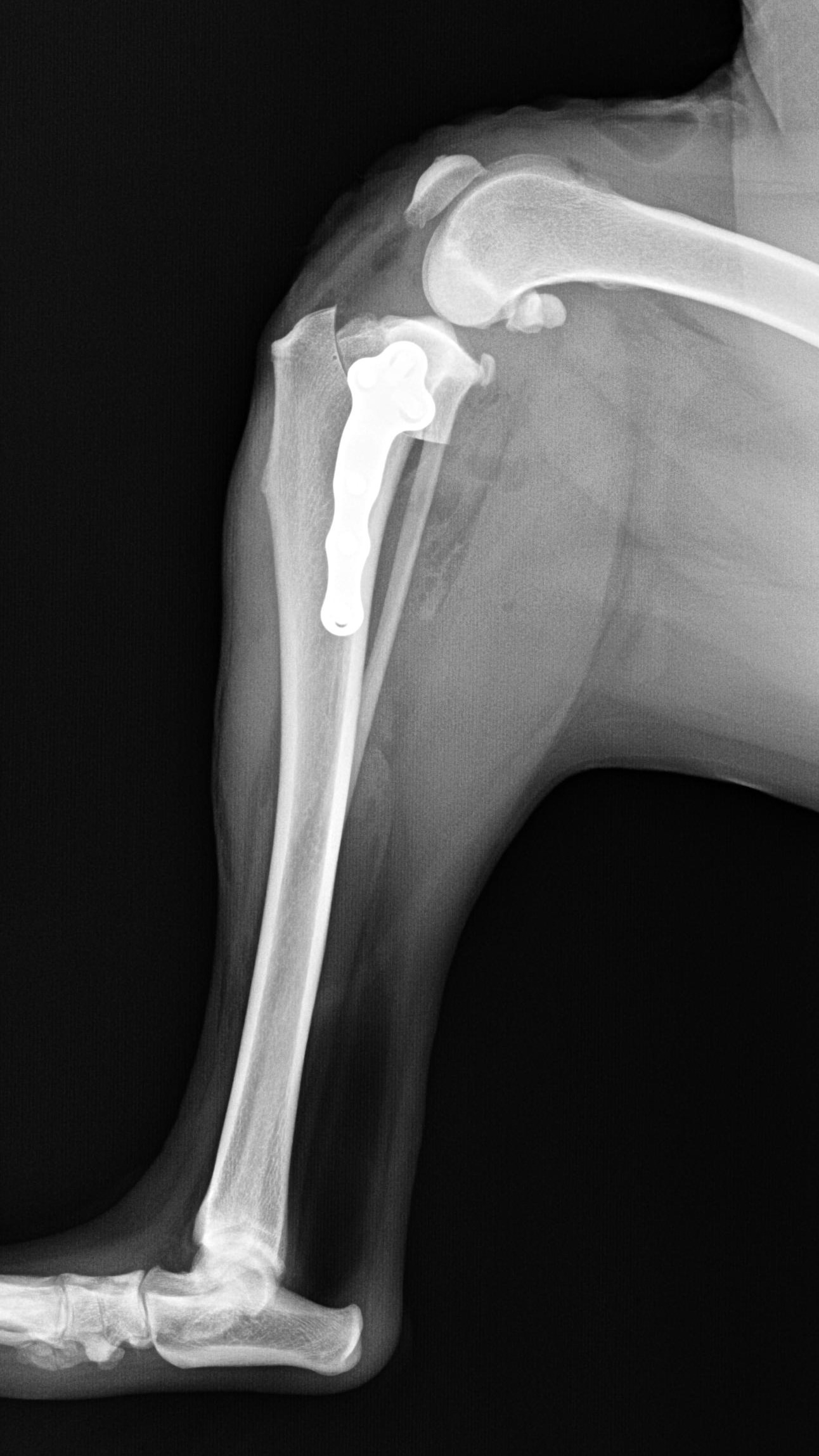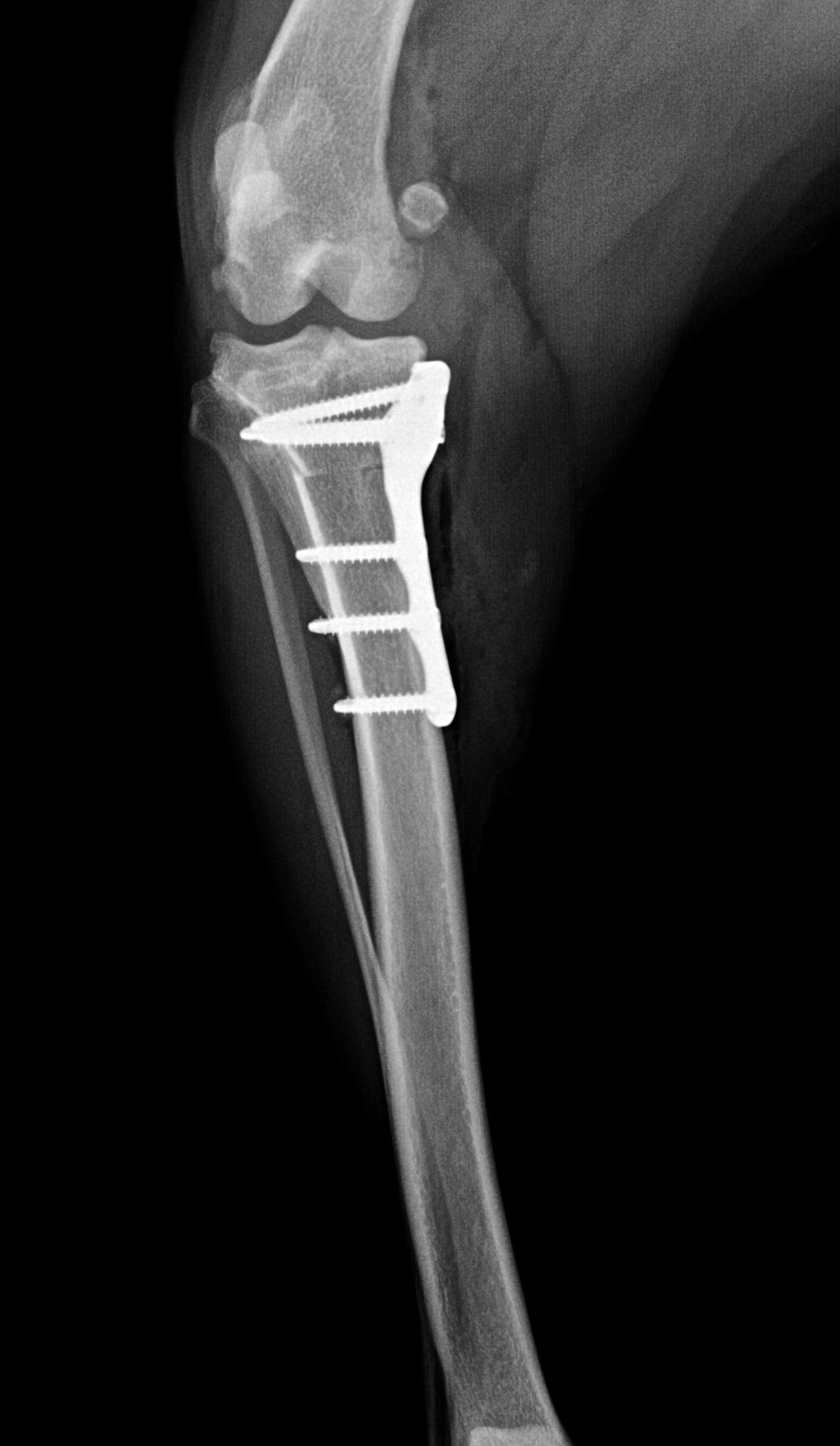Tibial Plateau Leveling Osteotomy (TPLO)
How Warm Springs Pet Hospital Can Help
We’ve performed approximately 2,000 TPLOs, making us one of the most experienced TPLO centers in the entire Bay Area!
For about 95% of our TPLO clients, we are not their established regular veterinarian. Rather, we are a second or third opinion and clients reach out to us to perform their pets’ knee surgery - as our costs may be more reasonable - and then they return to their regular veterinarian for future routine care. We are understanding of this and can email our surgical notes to your regular veterinarian for their records and follow-up. We do have very friendly and capable veterinarians on staff for everyday issues, but we may be too far away for some of our long-distance clients.
Currently, our fee for performing a TPLO is $4,800. This is the total cost. It includes pre-op and post-op x-rays the day of surgery, IV catheter, blood work, the completed surgery, antibiotics, pain medicines, and buster collar. Not included are any fees for follow-up visits, as many clients opt to have those done by their regular veterinarian.
Why did my dog’s ACL Tear?
In dogs, the tearing of the cranial cruciate ligament or CrCL ligament is by far the most common cause of knee pain. In people, this ligament is referred to as the anterior cruciate ligament (ACL). We’ll be referring to it as ACL here, as it’s easier for people to understand.
The top of a normal dog’s tibia (shin bone) tends to slope backwards at a very steep angle in the knee joint - much steeper than it does in humans. This creates a large force pushing the femur (thigh bone) backwards at all times. The ACL ligament is suppose to hold these bones together and prevent abnormal movement in the joint. However, there is only so much stress the ligament can take before it breaks.
In most dogs, there is no obvious trauma that causes the ACL to tear. They can be happily running in the yard, and then they are suddenly holding up one of their back legs. In reality, the ligament was slowly breaking down for months to get to that point. It was genetically predetermined to happen, and there is nothing you could have done to prevent this eventuality. Larger breeds are predisposed, but it can happen in small dogs too. We usually see this injury happen when dogs are 1-3 years old, but it can happen in elderly pets also.
What is the TPLO?
TPLO stands for Tibial Plateau Leveling Osteotomy. The surgeon makes a planned, curved cut just below the joint surface, on the shin bone. They then rotate the top of the cut bone so that the top surface of the shin bone is almost flat within the knee joint. This takes away the force causing the thigh bone to slip backwards and cause pain. In this procedure, we are not directly replacing the ligament, just changing the slope of the tibia, thus causing the ligament to be no longer be needed.
This surgery has the best long-term outcome of all the ACL surgeries devised. The only other surgery that we would consider equivalent is called the CBLO, and the technique and principle behind that is very similar to the TPLO. We usually recommend the CBLO in dogs that are still growing, or dogs with deformed knees. The other popular ACL procedures, such as the TTA and lateral suture, don’t give quite the same long-term results.
How is a torn ACL diagnosed?
1) Physical Exam: This is the most useful part of diagnosis. Your veterinarian will do a series of tests in the exam room that are very helpful in making a diagnosis. For pets that are hyper, tense, or not very friendly, we may need to give a sedative first to do the tests properly. These test involve putting the knee through a range of motion, and feeling the stability of the knee when certain forces are applied.
2) Radiographs (x-rays)
Even though the ACL ligament doesn’t directly show up on x-rays, veterinarians will still recommend taking x-rays of your limping pet for a few good reasons:
1. Sometimes there are other reasons for limping besides, or in addition to, a torn ACL. Think: bad arthritis, knee cap problems, hip problems, or broken bones.
2. There are common changes that happen to the knee after the ACL tears, and if we see these on x-ray, it further confirms our suspicions. Below, we elaborate on this further.
3. X-rays are needed to measure parts of the tibia, necessary for surgical planning later.
To the right, we’ve zoomed in on the images above to show you more detail on x-ray changes commonly seen with ACL injury.
1. The nearest image shows a red line and a blue line. The red line is how far out the joint is swollen on this dog. The blue line is where it should normally be.
2. The far image shows a front to back view of the knee. Notice the red arrow, pointing at the joint space on the inner knee. There should be a larger space between the femur and tibia there, and the lack of space means that the medial meniscus is out of place - a common occurrence with an ACL tear.
The Surgical Procedure
Planning
Based on the size of your pet and the slope of the top of the tibia, the Veterinarian will make calculations as to what size saw blade to use, where to make the cut, how much to rotate the bone fragment, and what size plate and screws to use.
Proper x-rays are very important in the planning. Therefore, even if x-rays have already been taken elsewhere, we re-take x-rays the day of the procedure while your pet is under sedation. These x-rays are not charged for, they just are for our surgeons’ benefit.
Hardware Used
We use KYON brand surgical implants. This is a leading Swiss orthopedic implant manufacturer. We’ve found their plates to have many advantages over other brands.
1. Strong, titanium alloy material which is superior to stainless steel plates in many ways.
2. Locking Screws: The screws lock into the plate and make the entire implant much stronger. This decreases the risk that the screws or plate will bend or break, compared with older non-locking screws.
3. Point Contact Design: The plate is designed to sit 1 mm off the surface of the bone to minimize damage to the bone’s blood supply. This speeds up healing and decreases the risk of infection. Most other plates don’t have this advantage.
4. Pre-Contoured Design: The plates are pre-shaped to the natural contour of the tibia so that they do not need to be contoured by the surgeon during the procedure. This speeds up the surgery time, which decreases infection risk.
Post-Op X-rays
Once the surgery is completed, we take post-operative x-rays to make sure that everything went according to plan.
The surgeon will ask the following:
1. Is the slope of the tibia acceptable now? A 5 degree slope is ideal, but anything less than 14 degrees will give us good results.
2. Is the bone cut in the ideal place?
3. Are the bone plate and screws appropriate in size for the patient?
4. Are all the screws in the ideal position?
There are many more things that we look at, but these are the obvious questions for the doctor.
Post-Surgical Instructions and Aftercare
Every clinic has a different protocol, and there is a lot of flexibility here. We’ve listed below just a general outline of what our hospital recommends:
Pick-up from surgery is the same day, during the 90 minutes before we close.
Items you go home with that day include a buster collar for your pet to wear for 2 weeks, antibiotics and multiple pain medicines, and a packet of detailed post-operative instructions.
We usually place skin stitches or staples that we’d like to remove in 14 days. Our technicians can help you with this and there is no charge for this visit. Sometimes, during this tech visit, we postpone the suture removal for another 5-7 days if we don’t think the stitches are quite ready to come out.
We like to see your pet back after 30 days and 60 days. During these visits, we will assess the leg and we will likely also recommend x-rays to confirm proper bone healing. About 25% of the time, we also ask for another follow-up visit at 90 days post-surgery, if the leg isn’t fully healed after 60 days.
Long-Term Outcomes
There is a 98% chance that you’ll be happy with your pet’s long-term healing after the surgery at our office.
Surgery success depends on a few factors:
1. How long has the leg been injured? The longer the injury, the worse the long-term outcome. Arthritis sets in quickly after a torn ACL, causing meniscus and cartilage damage that we can’t reverse.
2. Older animals and overweight animals heal slower and have more complications.
3. Pets that are hyper or hard to confine heal slower and have more complications. These complications include delayed bone healing, incision infection, or stitches that pop out too early.


